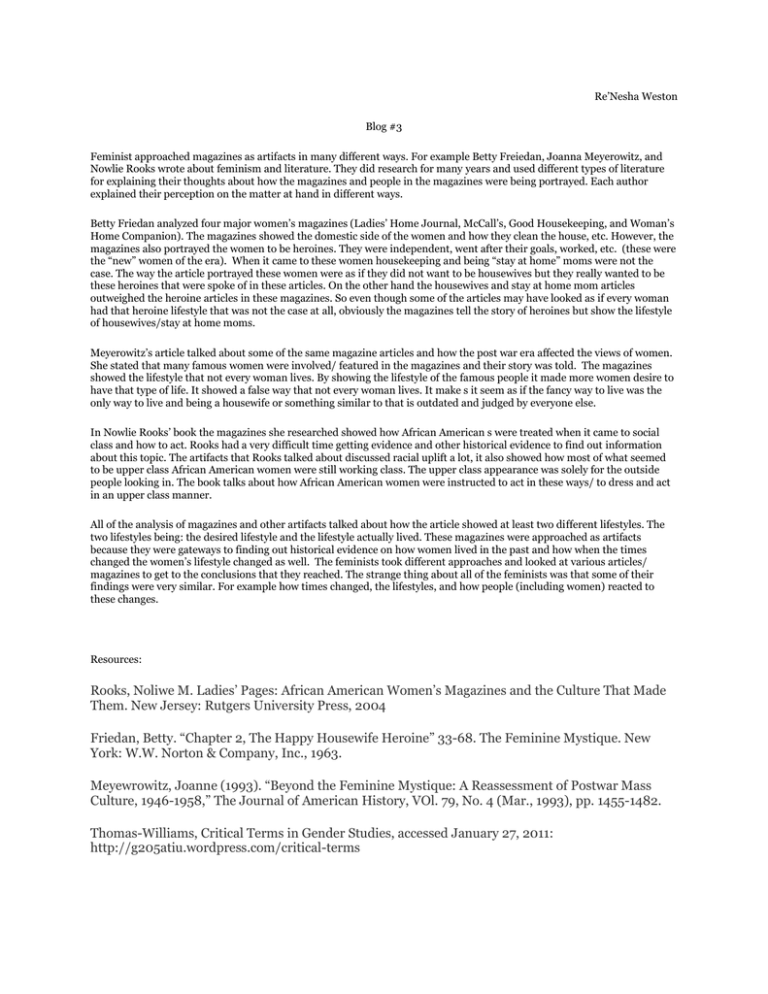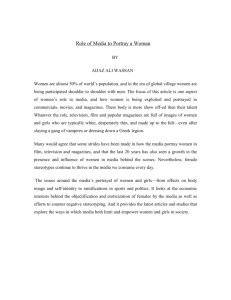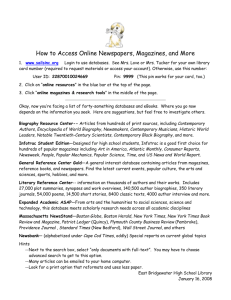Blog3 - WordPress.com
advertisement

Re’Nesha Weston Blog #3 Feminist approached magazines as artifacts in many different ways. For example Betty Freiedan, Joanna Meyerowitz, and Nowlie Rooks wrote about feminism and literature. They did research for many years and used different types of literature for explaining their thoughts about how the magazines and people in the magazines were being portrayed. Each author explained their perception on the matter at hand in different ways. Betty Friedan analyzed four major women’s magazines (Ladies’ Home Journal, McCall’s, Good Housekeeping, and Woman’s Home Companion). The magazines showed the domestic side of the women and how they clean the house, etc. However, the magazines also portrayed the women to be heroines. They were independent, went after their goals, worked, etc. (these were the “new” women of the era). When it came to these women housekeeping and being “stay at home” moms were not the case. The way the article portrayed these women were as if they did not want to be housewives but they really wanted to be these heroines that were spoke of in these articles. On the other hand the housewives and stay at home mom articles outweighed the heroine articles in these magazines. So even though some of the articles may have looked as if every woman had that heroine lifestyle that was not the case at all, obviously the magazines tell the story of heroines but show the lifestyle of housewives/stay at home moms. Meyerowitz’s article talked about some of the same magazine articles and how the post war era affected the views of women. She stated that many famous women were involved/ featured in the magazines and their story was told. The magazines showed the lifestyle that not every woman lives. By showing the lifestyle of the famous people it made more women desire to have that type of life. It showed a false way that not every woman lives. It make s it seem as if the fancy way to live was the only way to live and being a housewife or something similar to that is outdated and judged by everyone else. In Nowlie Rooks’ book the magazines she researched showed how African American s were treated when it came to social class and how to act. Rooks had a very difficult time getting evidence and other historical evidence to find out information about this topic. The artifacts that Rooks talked about discussed racial uplift a lot, it also showed how most of what seemed to be upper class African American women were still working class. The upper class appearance was solely for the outside people looking in. The book talks about how African American women were instructed to act in these ways/ to dress and act in an upper class manner. All of the analysis of magazines and other artifacts talked about how the article showed at least two different lifestyles. The two lifestyles being: the desired lifestyle and the lifestyle actually lived. These magazines were approached as artifacts because they were gateways to finding out historical evidence on how women lived in the past and how when the times changed the women’s lifestyle changed as well. The feminists took different approaches and looked at various articles/ magazines to get to the conclusions that they reached. The strange thing about all of the feminists was that some of their findings were very similar. For example how times changed, the lifestyles, and how people (including women) reacted to these changes. Resources: Rooks, Noliwe M. Ladies’ Pages: African American Women’s Magazines and the Culture That Made Them. New Jersey: Rutgers University Press, 2004 Friedan, Betty. “Chapter 2, The Happy Housewife Heroine” 33-68. The Feminine Mystique. New York: W.W. Norton & Company, Inc., 1963. Meyewrowitz, Joanne (1993). “Beyond the Feminine Mystique: A Reassessment of Postwar Mass Culture, 1946-1958,” The Journal of American History, VOl. 79, No. 4 (Mar., 1993), pp. 1455-1482. Thomas-Williams, Critical Terms in Gender Studies, accessed January 27, 2011: http://g205atiu.wordpress.com/critical-terms






